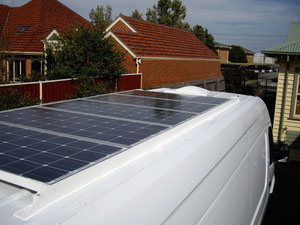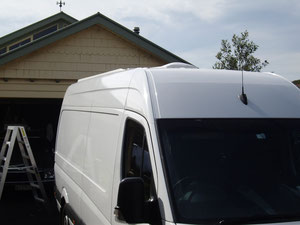My friend is making a show van a extended body early 80's Dodge, and has three of the Unisolar E-pvl68 that are 9 foor something long.
His plan is to fill up the corrugations with a non corrosive closed cell foam then fiberglassing over it, then have a thin sheet of stainless, to which the panels have already been adhered, attached to the roof. Not sure when he will get to that.
I have a PVL-68 that uses mc3 connectors. I painted my fiberglass roof, filled the little 'step' in the back with bondo, and ran the panel up and over the crown. There is a little ridge in the panel just past the apex as while it can bend, it cannot compress or stretch.
I am happy for the extra wattage in addition to my framed Kyocera 130 watt, But i want more.
No doubt Unisolar's output is lessened by heat since it is adhered directly to the roof and was designed to be.
If I were to do it over again I'd get the largest single framed panel like the Kyocera 325 watt, reenforce the frame a bit and support the center of the panel , a little better from underneath, and paint the aluminum frame white then get a MPPT charge controller capable of dealing with the high voltage.
I ran a bead of 3m 5200 around the perimeter of the Unisolar panel to cover the black Butyl edge. IT did not bond to the butyl. I also held the mc3 cables to the roof with blobs of 5200 every 8 inches or so.
I'm thinking of getting a flexible panel, and making a low profile frame for it to account from the crown on my roof in the space I have remaining, with a nod toward ventilation under it. But a larger Nod toward preventing flapping in the slipstream at 90mph
When the roof is curved, the slighest breeze over the roof will cause the air to accelerate under the flat panels. My framed Kyocera has a large junction box on the underside and I mounted it so that this was practically resting on the roof, and front two corners, there is barely 1/2 inch clearance.
I can tilt the panel upward. 90 degrees toward either side of the van, but when the directed at the sun at 10 noon and 2, there is no significant difference in Panel temp flat or tilted.
 :huh:
:huh:












































































